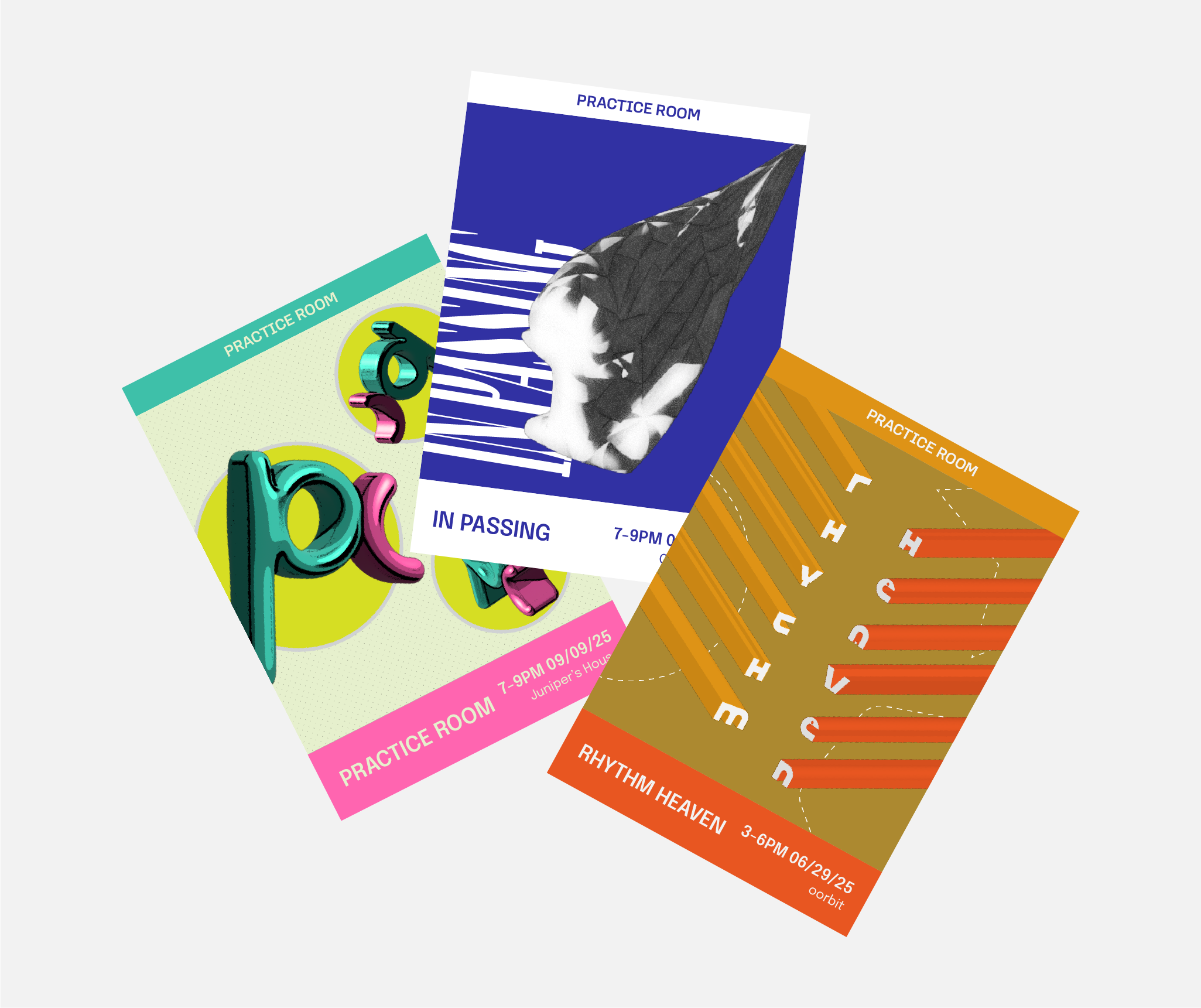| ID | Name | Type |
|---|---|---|
| 48 | practice room cards | Visual Design |
Details
Every practice room comes with a corresponding card of the event. Before the pop-up, they serve as a flyer, during the pop-up, they're a ticket, and afterwards, they become a memento.
They're a small, but key component of a practice room. They're an object where sentimentality can be placed, they're an artifact that people can collect, and they're documentation of continuity. Part of the appeal of cards is that they are fun to collect, it's exciting to get different cards, and to compare and look at what cards others have. Of course, the end goal isn't to just get people to collect another thing. Rather, the appeal of collecting cards is a way to convey the continuity and consistency that forms the groundwork for community building, that each practice room is fun, but many practice rooms is building towards something more—maybe a sustainable system of fun, for example. It's also a way to connect events that might not seem directly connected, how a film screening or a food pop-up or a vinyl listening event can all share connective tissue. And while companies might make these connections as brand-building strategies, they're used here as a way to communicate and solidify identity of a group of happenings.
At first encounter, the cards play a very simple role of advertising for an upcoming pop-up, usually while the card is still in its virtual form. Instead of a body-less visual design though, it is from the get-go framed as a card. It is positioned as an object with its own template, ratio, and size. When it comes to design, and especially design for advertising, so much of the art of it comes in service of the platform—most of what we do not get to control. We adapt the design to fit the platform, conform the shape of our flyers to be the same square that Instagram demands and then something a bit wider for Eventbrite, a bit taller for phones, etc. Limitation can create exciting results, but it also means we're letting the parameters be set by other forces, ones that often do not have our best interest in mind. It means that even before the first design element is created, the biggest creative decision has already been made by Facebook, Google, Canva etc. By designing our own template to work with, it's a demonstration that the very canvas we're painting on is malleable, and not only that, that it is crucial for us to apply our creative energy into the very tools and frames that contain our creative dreams.
practice rooms are not trying to compete or replicate more commercial or institutional spaces, but comparisons are inevitable just due to the proximity and overlap of function. Does this practice room replace the afterparty at my work, does this practice room replace the pop-up hosted by my local library, does this practice room take the place of the street festival hosted by Coca-Cola? And here the card teases the idea that even without the infrastructure or resources that these other events have access to, there are still ways to achieve the niceties we like from them. AMC screens a film and gives out a commemorative ticket, practice room can do a film screening for 5 people and also have a commemorative memento. Not only can we provide the event supplementals that these larger institutions provide, but we can provide them with more creativity and flexibility.
Plus, the small scale is a feature, not a drawback. Making a commemorative ticket for 5 people is a beautiful reframing of cards and tickets, things we associate as being one of hundreds or thousands. With most collections, the collector is anonymous, one of many, searching a sea of cards, trinkets, or whatever collectible items in search of finding the rare, the unique, the special, to make the collector and their collection special. The Pokémon card collector or baseball collector are striving for that 1 of 100 card, or that baseball from that one iconic home run. And one can argue the practice room cards are the same, there are often literally only 6 or 12 in existence in the whole world. And yet the effect is the opposite.
Everyone that attends a practice room gets a card, and while people might enjoy the cards, no one treats it as a rare artifact—and no one should. With the rare Pokémon card, the value is in the object, and so the aspiration is for the object with this valuation, valuation that comes from the fact that other people do not have this object. Even though the practice room cards have the same rarity, it's meant to have the opposite effect. The quality of the card makes it known that it was just produced with a simple inkjet printer, many more can be made from there. There is a knowledge that cards will be produced for everyone that shows up, that if they lose a card, they can get another one printed and given to them. The value is entirely on what the person involved here ascribes to it, what meaning the person receiving it gives it. And this is a model of abundance. With its production, the cards have the meaning that I've outlined above, but from there, people can build upon it, mutate it, enhance it. The cards as objects are no longer special, even if they are rare, because there is now this understanding that what is special is within each person that shows up to a practice room, and each relationship that gets built. The card itself is not what's valuable, instead it is a nice memory of the beautiful abundant energy of community and relationship-building—which is the actual valuable piece here. practice room cards reframe the collectable card or ticket from an object of scarcity into an object representing abundance.

